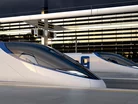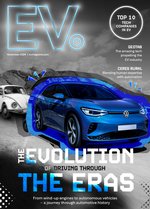HS2 will be the electrified rail link between UK cities

The next generation of e-mobility has already entered the UK with the High Speed 1 (HS1) Ltd rail line connecting London to the Channel Tunnel, leveraging the UK’s fastest train.
HS1 prides itself on adopting more and more solar and wind solutions to power the country’s high-speed train with renewable energy sources, but progress doesn’t stop there.
The latest, fastest rail line is under construction by HS2 Ltd, which set out to connect major cities in the UK, starting with a rail link from London to Birmingham—as Phase One of the project—before further extensions to include Crewe (Phase 2a), Manchester (Phase 2b), Sheffield and Leeds (HS2 East), and the Northern Powerhouse Rail to connected Warrington and Yorkshire.
The latest development from HS2 is the first viaduct pier built at Birmingham city centre, which is a major milestone for the rail line and will allow the train to connect to Curzon Street Station. 30 of the piers will be required to allow the HS2 to enter the city, travelling between five and six metres above ground.
“It’s fantastic to see this first viaduct pier complete on the Curzon Street site, which starts to bring the design vision for this iconic structure to life,” says David Kind, Senior Project Manager for Curzon Street at HS2.
“Construction on this site is supporting hundreds of skilled jobs in the region, and once built, Curzon Street Station will put Birmingham at the heart of the new zero-carbon high speed network.”
“We’re also pleased to see eco-friendly materials being used in the construction method, supporting HS2’s ambition to cut carbon across the project.”
More exciting news came at the beginning of 2023 as HS2 published a bill that sets out legislation for Phase 2b of its high speed network, which will create a further 52 miles (85 km) of rail to incorporate Manchester.
Not only will this act as an integral link between the cities, but is also expected to support around 17,500 jobs during the construction stage of Phase 2b.
‘It’s encouraging to see the bill for HS2’s Western Leg deposited in Parliament,” says Darren Caplan, CEO at the Rail Industry Association.
“Rail businesses up and down the country stand ready to support this transformational project, supporting jobs and investment [while] delivering a new sustainable railway for the nation.”
How fast is the HS2 zero-carbon train?
HS2 has already declared that the HS2 will be capable of travelling at immense speeds of up to 225 mph (360 km/h) and is expected to eventually link the UK capital with Glasgow and Edinburgh in Scotland via an existing rail network in the North.
As a result of its high-speed capability, the zero-carbon train is expected to cut travel times between London and Glasgow by 49 minutes, and the journey between Edinburgh and Birmingham by 43 minutes.
“HS2 has an integral role to play in levelling up and rebalancing Britain’s economy, and this extension of the network fuels that role by bringing the country’s economic centres in the North and Midlands closer together,” says Mark Thurston, CEO at HS2 Ltd.
“Construction of the first phase of HS2 is already supporting over 20,000 jobs and spearheading investment and growth in major population centres along the route. The Bill is a vote of confidence in HS2’s ability to help towns and cities in the North realise their economic potential.”
What makes the HS2 train sustainable?
From the outset, the plan for the HS2 train was to create a zero-carbon transport mechanism, which is critical in decarbonising national transport and shifting away from domestic flights and long-haul car trips.
The aim for the project is to be as sustainable as possible through the use of responsibly-sourced construction materials and lean building methods—a major part of the wider net-zero carbon strategy of HS2. The result will be net-zero emissions by 2035.



